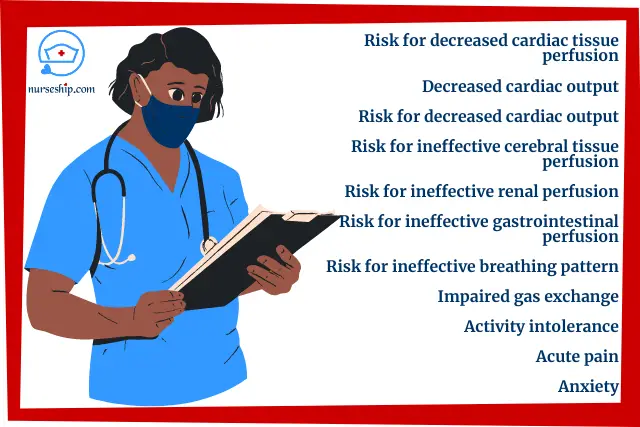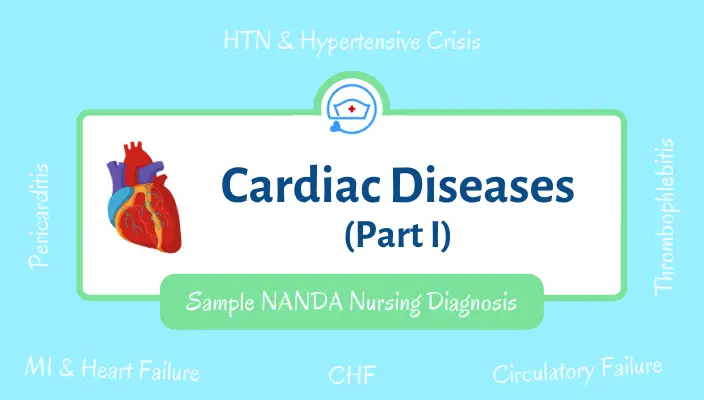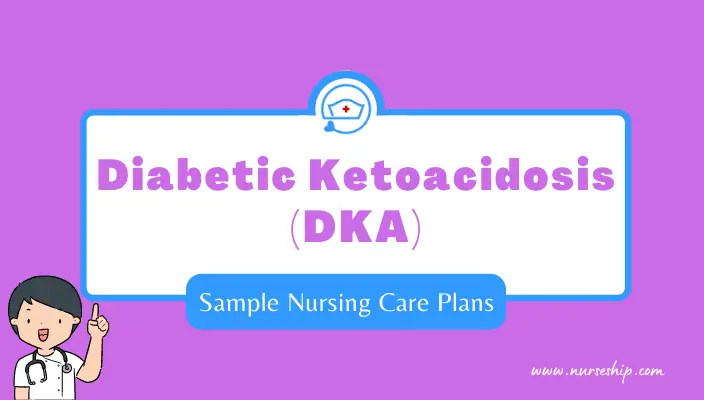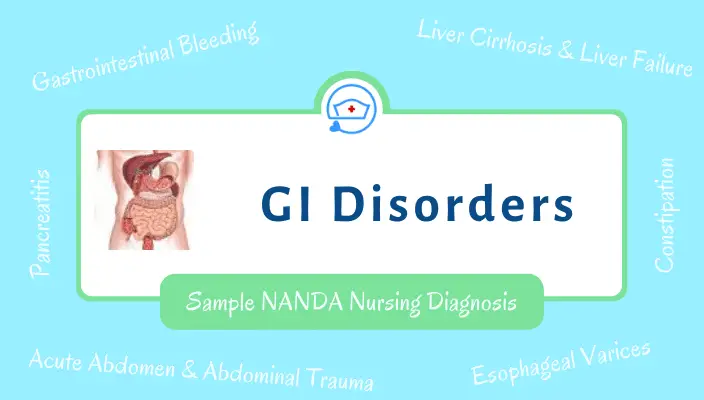Here you will find a list of NANDA nursing diagnosis for various disease conditions of the Cardiovascular System.
Use the table of contents to jump the part you need.
Click here to see part 2.
NANDA Nursing Diagnosis for Myocardial Infarction (MI), Left-Sided Heart Failure, and Right-Sided Heart Failure
Acute pain
May be related to: decreased blood flow to the myocardium, myocardial ischemia or infarct, post-procedure discomfort, chest wall pain post-surgery, pericarditis.
As evidenced by: chest pain with or without radiation, facial grimacing, clutching of hands or chest, restlessness, diaphoresis, changes in pulse and blood pressure, dyspnea, dizziness.
Decreased cardiac tissue perfusion
Risk for decreased cardiac tissue perfusion
Risk for ineffective cerebral tissue perfusion
Ineffective cerebral tissue perfusion
May be related to: tissue ischemia, reduction or interruption of blood flow, vasoconstriction, hypovolemia, shunting, depressed ventricular function, dysrhythmias, conduction defects.
As evidenced by: abnormal hemodynamic readings, dysrhythmias, decreased peripheral pulses, cyanosis, decreased blood pressure, shortness of breath, dyspnea, cold and clammy skin, decreased mental alertness, changes in mental status, oliguria, anuria, sluggish capillary refill, abnormal electrolyte, hypoxia, ABG changes, chest pain, ventilation perfusion imbalances, changes in peripheral resistance, impaired oxygenation of myocardium, ECG changes in S-T segment, T wave, U wave, palpitations.
Decreased cardiac output
May be related to: damaged myocardium, decreased contractility, dysrhythmias, conduction defects, alteration in preload and afterload, vasoconstriction, myocardial ischemia, ventricular hypertrophy.
As evidenced by: elevated blood pressure, elevated mean arterial pressure greater than 120 mmHg, elevated systemic vascular resistance greater than 1400 dyne-seconds/cm5, cardiac output less than 4 L/min or cardiac index less than 2.7 L/min/m2, increased heart rate, cold, pale extremities, absent or decreased peripheral pulses, ECG changes, hypotension, S3 or S4 gallops, decreased urinary output, diaphoresis, orthopnea, dyspnea, crackles (rales), jugular vein distention, edema, chest pain.
Risk for fluid volume excess
May be related to: increased sodium and water retention, decreased organ perfusion.
As evidenced by: edema, weight gain, intake greater than output, increased blood pressure, increased heart rate, shortness of breath, dyspnea, orthopnea, crackles (rales), oliguria, jugular vein distention, pleural effusion, specific gravity changes, altered electrolyte levels.
Activity Intolerance
May be related to: generalized weakness, imbalance between oxygen supply and demand.
As evidenced by: Verbalization of fatigue or weakness, abnormal heart rate or BP in response to activity, exertional discomfort, shortness of breath, dyspnea, ECG changes reflecting ischemia and dysrhythmias.
Anxiety
May be related to: change in health status, fear of death, threat to body image, threat to role functioning, pain.
As evidenced by: restlessness, insomnia, anorexia, increased respirations, increased heart rate, increased blood pressure, difficulty concentrating, dry mouth, poor eye contact, decreased energy, irritability, crying, feelings of helplessness.
Knowledge deficit
May be related to: lack of understanding, lack of understanding of the medical condition, lack of recall.
As evidenced by: questions regarding problems, inadequate follow-up on instructions given, misconceptions, lack of improvement of the previous regimen, development of preventable complications.
Click here to see part 2.
NANDA Nursing Diagnosis for Hypertension and Hypertensive Crisis
Acute pain
May be related to: increased cerebral vascular pressure
As evidenced by: throbbing pain located in the suboccipital region, reluctance to move the head, rubbing head, avoidance of bright lights and noise, wrinkled brow, clenched fists, changes in appetite, neck stiffness, dizziness, blurred vision, nausea, and vomiting.
Decreased cardiac output
Risk for decreased cardiac output
May be related to: vasoconstriction, increased preload, increased afterload, ventricular hypertrophy, ischemia.
As evidenced by: elevated blood pressure, decreased cardiac output, decreased stroke volume, increased peripheral vascular resistance, increased systemic vascular resistance.
Decreased cardiac tissue perfusion
Risk for decreased cardiac tissue perfusion
Ineffective cerebral tissue perfusion
Risk for ineffective cerebral tissue perfusion
Risk for ineffective renal perfusion
Ineffective renal perfusion
May be related to: increased catecholamine stimulation, increased blood pressure, decreased cardiac output, decreased baroreceptor sensitivity, changes in cerebrospinal fluid pressure, angiotensin and aldosterone stimulation, sodium intake, environmental factors, genetic factors, strain on arterial wall, atherosclerosis
As evidenced by: increased blood pressure, retinopathy, retinal hemorrhage, headache, epistaxis, tachycardia, crackles, S3 or S4 gallops, restlessness, bruits to femoral, carotids, and abdominal aorta; blurred vision, chest pain, shortness of breath, optic disc papilledema, seizures, coma, nystagmus, mental status changes.
Activity Intolerance
May be related to: generalized weakness, imbalance between oxygen supply and demand, sedentary lifestyle.
As evidenced by: Verbalization of fatigue or weakness, abnormal heart rate or BP in response to activity, exertional discomfort, shortness of breath, dyspnea
Imbalanced nutrition: more than body requirements
May be related to: poor dietary habits, lack of exercise, excessive eating compared to nutritional needs, eating in response to emotional cues or external stimuli, poor dietary habits, lack of knowledge about appropriate portion size and food preparation.
As evidenced by: increased BMI, undesirable eating patterns, and sedentary lifestyle.
Ineffective coping
May be related to: Situational crisis, multiple life changes, inadequate relaxation, insufficient physical exercise, work overload, inadequate support systems, unmet expectations, unrealistic perceptions, ineffective coping methods, gender differences in coping strategies.
As evidenced by: Verbalization of inability to cope or ask for help, inability to meet role expectations or basic needs, destructive behavior toward self, overeating or lack of appetite, excessive smoking or drinking, chronic fatigue or insomnia, muscular tension, frequent headaches and neck pain, chronic worry, irritability, anxiety, emotional tension, depression.
Anxiety
May be related to: change in health status, fear of death, threat to body image, threat to role functioning, pain.
As evidenced by: restlessness, insomnia, anorexia, increased respiration, increased heart rate, increased blood pressure, difficulty concentrating, dry mouth, poor eye contact, decreased energy, irritability, crying, feelings of helplessness.
Knowledge deficit
May be related to: lack of understanding, lack of understanding of the medical condition, lack of recall.
As evidenced by: questions regarding problems, inadequate follow-up on instructions given, misconceptions, lack of improvement of the previous regimen, development of preventable complications.

NANDA Nursing Diagnosis for Congestive Heart Failure (CHF)
Click here to see a sample Nursing Care Plan for a Patient with Acute exacerbation of Congestive Heart Failure (CHF).
Fluid volume excess
May be related to: increased sodium and water retention, decreased organ perfusion, compromised regulatory mechanisms, decreased cardiac output, increased ADH production.
As evidenced by: edema, weight gain, intake greater than output, increased blood pressure, increased heart rate, shortness of breath, dyspnea, orthopnea, crackles (rales), S3 gallop, oliguria, pleural effusion, specific gravity changes, jugular vein distention, altered electrolyte levels.
Decreased cardiac output
Risk for decreased cardiac output
As evidenced by: dependent edema, elevated blood pressure, elevated mean arterial pressure greater than 120 mmHg, tachycardia, cold, pale extremities, absent or decreased peripheral pulses, ECG changes, hypotension, S3 or S4 gallops, decreased urinary output, diaphoresis, orthopnea, dyspnea, crackles (rales), frothy blood-tinged sputum, jugular vein distention, edema, chest pain, confusion, restlessness, elevated systemic vascular resistance greater than 1400 dyne-seconds/cm5, cardiac output less than 4 L/min or cardiac index less than 2.5 L/min/m2.
Risk for impaired gas exchange
Impaired gas exchange
May be related to: ventilation/perfusion imbalance caused by excess fluid in alveoli and reduction of air exchange area in lung fields, fluid collection shifts into the interstitial space.
As evidenced by: confusion, restlessness, irritability, hypoxia, hypercapnia, dyspnea, orthopnea, abnormal ABGs, abnormal oxygen saturation.
Anxiety
May be related to: change in health status, fear of death, threat to body image, threat to role functioning, pain.
As evidenced by: restlessness, insomnia, anorexia, increased respiration, increased heart rate, increased blood pressure, difficulty concentrating, dry mouth, poor eye contact, decreased energy, irritability, crying, feelings of helplessness.
Knowledge deficit
May be related to: lack of understanding, lack of understanding of the medical condition, lack of recall
As evidenced by: questions regarding problems, inadequate follow-up on instructions given, misconceptions, lack of improvement of the previous regimen, development of preventable complications.
Click here to see part 2.
NANDA Nursing Diagnosis for Pericarditis
Acute pain
May be related to: pericardial inflammation, infection, chest trauma.
As evidenced by: chest pain, fever, weakness and tiredness, coughing, shortness of breathing, dyspnea, pain when swallowing, and palpitations, arrhythmias, ECG changes (such as diffuse concave upward ST-segment elevation, ST-segment depression in aVR, and PR-segment depression).
Decreased cardiac tissue perfusion
Risk for decreased cardiac tissue perfusion
Risk for ineffective cerebral tissue perfusion
Ineffective cerebral tissue perfusion
May be related to: tissue ischemia, reduction or interruption of blood flow, vasoconstriction, hypovolemia, shunting, depressed ventricular function, dysrhythmias, conduction defects.
As evidenced by: abnormal hemodynamic readings, dysrhythmias, decreased peripheral pulses, cyanosis, decreased blood pressure, shortness of breath, dyspnea, cold and clammy skin, decreased mental alertness and changes in mental status, oliguria, anuria, reduced capillary refill, hypoxia, ABG changes, chest pain, ventilation-perfusion imbalances, changes in peripheral resistance, impaired oxygenation of the myocardium, ECG changes (S-T segment, T wave, U wave), LV enlargement, palpitations.
Decreased cardiac output
Risk for decreased cardiac output
May be related to: fluid in the pericardial sac from pericardial effusion, potential for cardiac tamponade because of effusion, damaged myocardium, decreased contractility, dysrhythmias, conduction defects, alteration in preload, alteration in afterload, vasoconstriction, myocardial ischemia.
As evidenced by: decreased blood pressure, tachycardia, pulsus paradoxus greater than 10 mmHg, distended neck veins, increased central venous pressure, dysrhythmias, decreased QRS voltage or electrical alternans, diminished heart sounds, dyspnea, friction rub, cardiac output less than 4 L/min, cardiac index less than 2.5 L/min/m2.
Anxiety
May be related to: change in health status, fear of death, threat to body image, threat to role functioning, pain.
As evidenced by: restlessness, insomnia, anorexia, increased respirations, increased heart rate, increased blood pressure, difficulty concentrating, dry mouth, poor eye contact, decreased energy, irritability, crying, feelings of helplessness.
Knowledge deficit
May be related to: lack of understanding, lack of understanding of medical condition, lack of recall
As evidenced by: questions regarding problems, inadequate follow-up on instructions given, misconceptions, lack of improvement of the previous regimen, development of preventable complications.
NANDA Nursing Diagnosis for Cardiogenic and Noncardiogenic Shock (Circulatory Failure)
Risk for ineffective peripheral tissue perfusion
Ineffective peripheral tissue perfusion
Decreased cardiac tissue perfusion
Risk for decreased cardiac tissue perfusion
Risk for ineffective cerebral tissue perfusion
Ineffective cerebral tissue perfusion
Risk for ineffective renal perfusion
Ineffective renal perfusion
Risk for electrolyte imbalance
Electrolyte imbalance
May be related to: decreased circulating blood volume
As evidenced by: severe hypotension or unrecordable blood pressure, feeble or unpalpable carotid pulse, unresponsiveness, anuria, oliguria, deranged serum sodium and potassium, clammy skin, cyanosis, mental status changes.
NANDA Nursing Diagnosis for Thrombophlebitis
Acute pain
May be related to: inflammation, impaired blood flow, intermittent claudication, venous stasis, lactic acid in tissues, surgical procedures, fever.
As evidenced by: complaints of pain, tenderness to touch, aching, burning, restlessness, facial grimacing, guarding of extremity.
Risk for ineffective peripheral tissue perfusion
Ineffective peripheral tissue perfusion
Risk for decreased cardiac tissue perfusion
Risk for ineffective cerebral tissue perfusion
May be related to: IV infiltration, impaired blood flow, venous stasis, venous obstruction.
As evidenced by: pain, tissue edema, local redness, decreased peripheral pulses, prolonged capillary refill time, pallor, cyanosis, erythema, paresthesia.
Risk for impaired skin integrity
May be related to: edema, venous stasis, bedrest, surgery, pressure, altered circulation and blood flow, altered metabolic states.
As evidenced by: skin surface disruptions, incisions, ulcerations, wounds that do not heal.
Hyperthermia
May be related to: infection, inflammation, abscess.
As evidenced by: body temperature greater than normal range, flushed warm skin, chills, increased heart rate, increased respiratory rate.
Risk for infection
May be related to: infection, inflammation, predisposition to bacteremia, suprainfection.
Anxiety
May be related to: change in health status, fear of death, threat to body image, threat to role functioning, pain.
As evidenced by: restlessness, insomnia, anorexia, increased respiration, increased heart rate, increased blood pressure, difficulty concentrating, dry mouth, poor eye contact, decreased energy, irritability, crying, feelings of helplessness.
Knowledge deficit
May be related to: lack of understanding, lack of understanding of medical condition, lack of recall
As evidenced by: questions regarding problems, inadequate follow-up on instructions given, misconceptions, lack of improvement of the previous regimen, development of preventable complications.
Reference
Herdman, T. and Kamitsuru, S., 2018. NURSING DIAGNOSES: Definitions and Classifications 2018-2020. 11th ed. New York: Thieme.
Gulanick, M. and Myers, J., 2014. NURSING CARE PLANS: Diagnoses, Interventions, and Outcomes. 8th ed. Philadelphia: Elsevier/Mosby.
Comer, S. and Sagel, B., 1998. CRITICAL CARE NURSING CARE PLANS. Englewood, CO: Skidmore-Roth Publications.
Swearingen, P., 2016. ALL-IN-ONE CARE PLANNING RESOURCE. 4th ed. Philadelphia, PA: Elsevier/Mosby.




